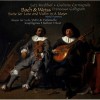Composers
Karl Ignaz Augustin Kohaut (Carolus Ignatius Augustinus) (baptised August 26, 1726 – August 6, 1784) was an Austrian lutenist and composer of Czech descent. He is considered (along with Bernhard Joachim Hagen) to be one of the last important composers of music for Baroque Lute.
Born in Vienna, Karl Kohaut pursued a dual career as a diplomat and musician. He entered the Austrian civil service in 1756 or 1757 as a minor official in the state chancellery, but by 1778 he had reached the position of court secretary.
He was active as a violinist in performances organized by Gottfried van Swieten (in quartets by Haydn and Mozart), but he was most widely admired as a lutenist. He is recorded to have appeared as the soloist in a performance of one of his own lute concertos at the Tonkünstler-Societät on 17 March 1777, during which one of his symphonies was also performed.
Kohaut wrote seven lute concertos, which are fine examples of this rare genre. The concerto in F major is probably most well known, having been recorded at least four times: by Julian Bream, Alirio Díaz, John Schneiderman and Hopkinson Smith. Kohaut's eight masses were frequently performed at the monasteries of Melk and Göttweig, especially the Missa Sancti Willibaldi, which was performed at Göttweig on 24 occasions, the last time as late as 1798. Kohaut's Symphony in F minor was his best known work during the 20th century, recorded on LP on the Supraphon label.
Refine by search
view all| Country: | Austria |
| Period: | Renaissance |
Biography
Karl Ignaz Augustin Kohaut (Carolus Ignatius Augustinus) (baptised August 26, 1726 – August 6, 1784) was an Austrian lutenist and composer of Czech descent. He is considered (along with Bernhard Joachim Hagen) to be one of the last important composers of music for Baroque Lute.
Born in Vienna, Karl Kohaut pursued a dual career as a diplomat and musician. He entered the Austrian civil service in 1756 or 1757 as a minor official in the state chancellery, but by 1778 he had reached the position of court secretary.
He was active as a violinist in performances organized by Gottfried van Swieten (in quartets by Haydn and Mozart), but he was most widely admired as a lutenist. He is recorded to have appeared as the soloist in a performance of one of his own lute concertos at the Tonkünstler-Societät on 17 March 1777, during which one of his symphonies was also performed.
Kohaut wrote seven lute concertos, which are fine examples of this rare genre. The concerto in F major is probably most well known, having been recorded at least four times: by Julian Bream, Alirio Díaz, John Schneiderman and Hopkinson Smith. Kohaut's eight masses were frequently performed at the monasteries of Melk and Göttweig, especially the Missa Sancti Willibaldi, which was performed at Göttweig on 24 occasions, the last time as late as 1798. Kohaut's Symphony in F minor was his best known work during the 20th century, recorded on LP on the Supraphon label.



